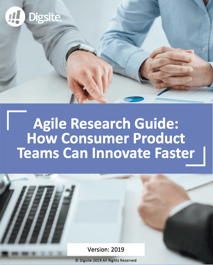Agile research is transforming the way organizations large and small collect the insights and data they need to solve challenging problems and build transformative innovation.
That’s because agile approaches focus on earlier and more iterative research than traditional stage-gate methods—and give you more flexibility to adjust as you learn. With agile research, you can test something, find out more information—why people feel the way they do—revise your hypothesis, test again, and continue the process until you’ve arrived at a solution you’re comfortable with.
Like anything else, however, you can’t simply decide to try your hand at agile research and expect great results automatically. Some methods trade off speed for quality, leaving your team unsatisfied with the results, ultimately wasting time and money on research that didn’t drive decision making.
With that in mind, let’s take a look at five secrets to help ensure your agile research efforts will succeed.
1. Find your purpose
First things first: You need to understand why you’re transitioning your approach to agile research. You need to have a mission and purpose behind the change.
Companies move to agile for different reasons.
Sometimes, change comes from the bottom up. In these situations, insights teams are looking to improve their responsiveness to business teams and become mission critical to important company initiative. If your team is seen as too slow, too expensive, or not responsive enough—research will often be forgone altogether.
Giustina Parisi, consumer and portfolio insights manager at American Family Insurance, found herself in this exact position.
“Teams were already finding ways to work around us—we were seen as expensive bottlenecks,” she says.
Sometimes changes came from the top down. Mark Hetrick, consumer and marketing insights manager at Pella, got input from senior management that a different approach was needed.
“Everybody recognized that the pace of business is only getting faster,” he says. “We needed to respond accordingly or we were going to be left behind.”
Bottom line? Whether lower-level teams need to move faster or senior-level executives are pushing for digital transformation, you need to find a purpose before making the move.
2. Inspire change
At a very basic level, agile research is about finding answers faster, moving more quickly, and making better decisions. The end result is better products and services—and happier customers.
With the right approach, agile can make work more fun and engaging for employees. Teams get the chance to be scrappy and experiment. They get to learn how to use new tools and try new things. Ultimately, because their efforts are data-driven, they get better results too.
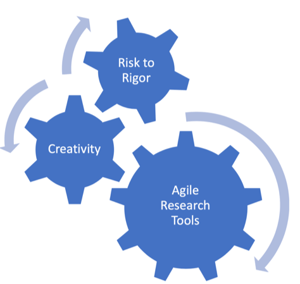
“Agile is becoming the way we do research,” says Cory Lommel, director of consumer insights at Cargill. “It’s exciting and liberating.”
When you’re moving to agile, be aspirational. Inspire change for all of your colleagues. Get them excited to sharpen their skills and do theirbest work.
3. Build your guiding principles
Agile isn’t about the numbers. You don’t need to survey thousands of people to figure out your next move. If you talk to 20 people and it is clear that the potential solution you were considering won’t work for their specific situations, you don’t need to ask 1,000 people purchase intent in a survey.
Instead, depth is what matters most.
As you begin your agile efforts, build your guiding principles. Remember, it’s all about getting in-context learning so you can build and test simultaneously. You can iterate during your research—and you can also iterate on your own approach to agile research, adjusting it after each sprint to build an increasingly more effective engine.
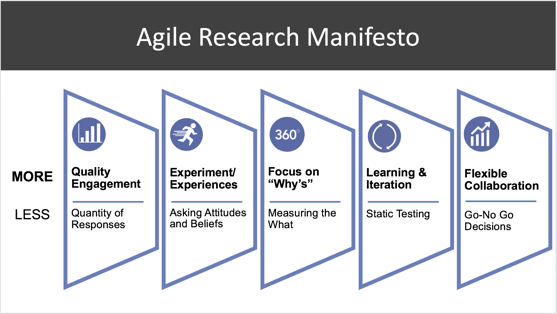
4. Challenge your assumptions
Even though quick, automated surveys might appear agile, they may not fit your needs for in-context research. Instead, you may need modern approaches for recruiting and data analysis tied to more qualitative style research activities. Qualitative research has historically been expensive and time consuming. In person approaches mean your team might have to fly across the country—which costs money, too. And typical qualitative process of capturing experiences is also static—you get answers, but they only represent a snapshot in time.
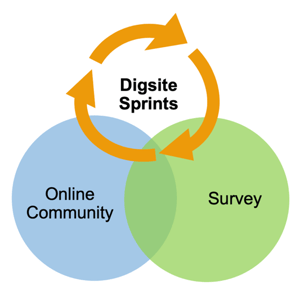
And agile research tools like Digsite offer online approaches to uncover deeper insights and capture in-context learning, such as live video interviews, photo and video sharing, fill-in-the-blank stories, and white board exercises—to find the answers you’re looking for.
Recently, Tillamook—a company which has been serving up quality cheese and dairy products for more than 100 years—was trying to gainmore market share in the $5.3 billion category. They turned to Digsite and were able to drive 26% growth in a sector that’s not necessarily known for innovation. Thanks to agile research, they were able to come up with a consumer-inspired name, changing their packaging and positioning to introduce a product that met the needs of their audience.
When you’re considering agile, look at the quality and the speed together to ensure you can conduct deeper research in less time.
5. Measure your success
Transforming from a company that approaches research the traditional way into an agile-first organization is only possible if you get your team to buy in.
An easy way to convince even the most skeptical colleagues to give agile a whirl is to measure your success. That way, you can bring data to the table when selling it in the next meetings.
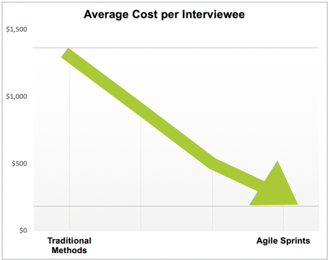
One customer who was using one-on-one interviews to vet new ideas was able to complete 10 times more studies on the same budget,
moving research timelines from three to six weeks to three to six days. Another customer was able to demonstrate not only bringing products to market faster—and they were also able to generate 250% ROI on warranty claims.
By measuring your success and showing the impact on meeting the organizations goals, it’ll be that much easier to bake agile research into the foundation of your organization.
Agile is more than just a platform or set of tools—it’s a mindset
If you’re looking to bring better products to market faster, it’s worth exploring agile research.
But online qualitative technology like Digsite is only half of the equation. In addition to a robust agile research provider, you also need the right governing philosophies and mindsets.
With a solid framework in place and the tools needed to help you deliver, you can unlock the full potential of agile research—delighting stakeholders and customers along the way.
To learn more about how agile research can transform the way your organization builds, positions, and packages products, check out our guide to Agile Research.
